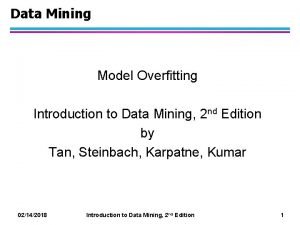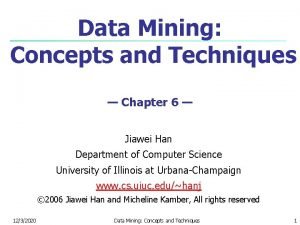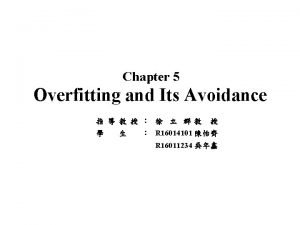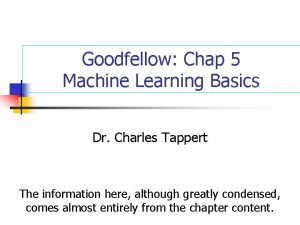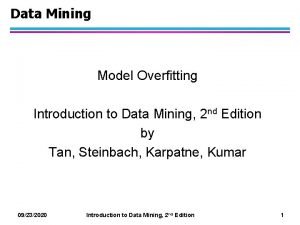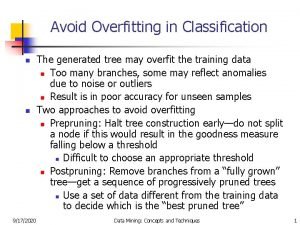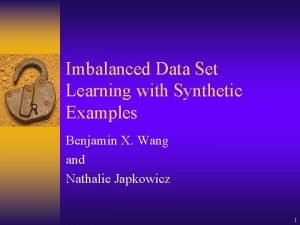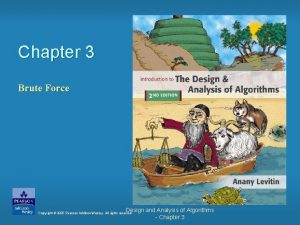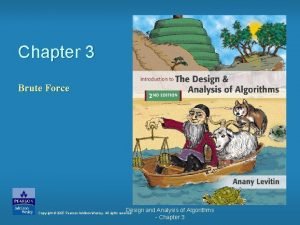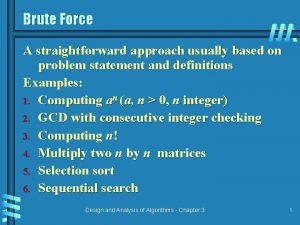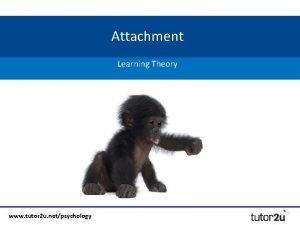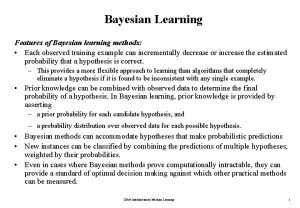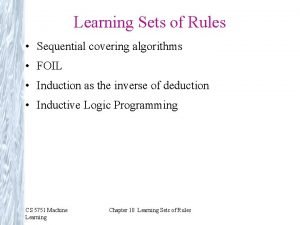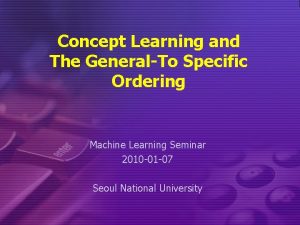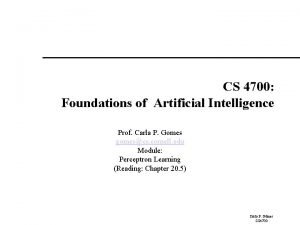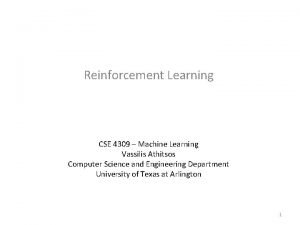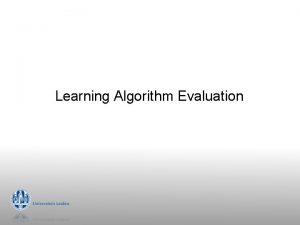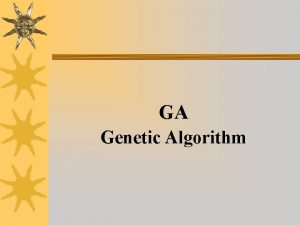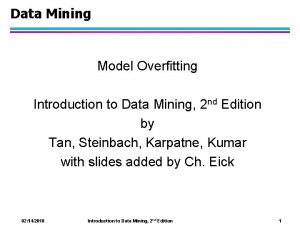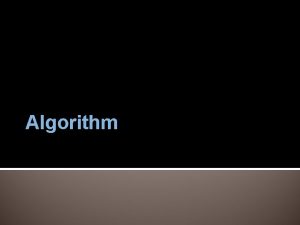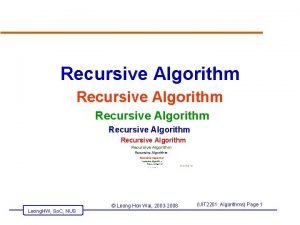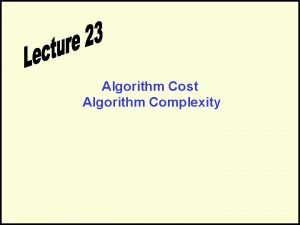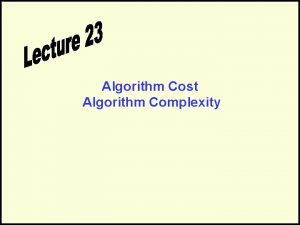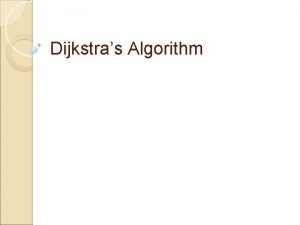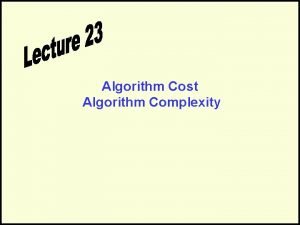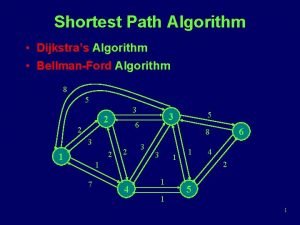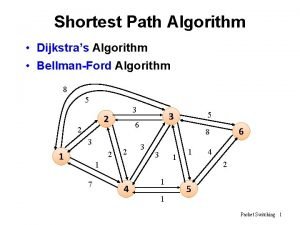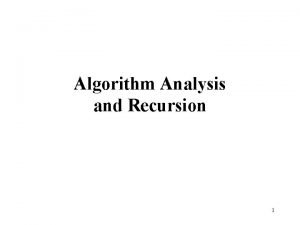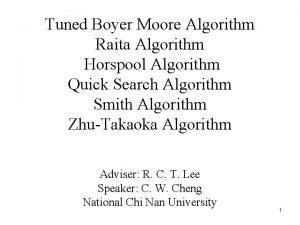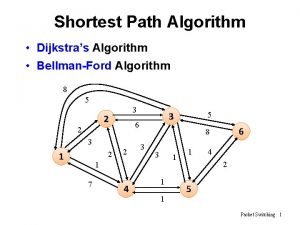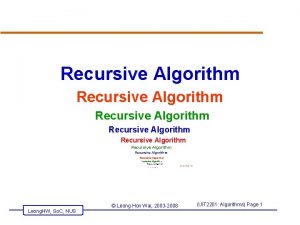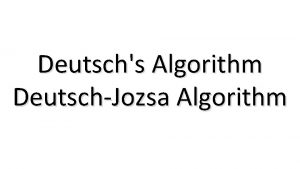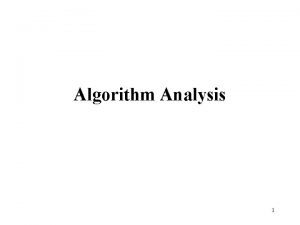Learning Algorithm Evaluation Introduction Overfitting Overfitting A model





























- Slides: 29

Learning Algorithm Evaluation

Introduction

Overfitting

Overfitting A model should perform well on unseen data drawn from the same distribution

Evaluation Rule #1 Never evaluate on training data

Train and Test Step 1: Randomly split data into training and test set (e. g. 2/3 -1/3) a. k. a. holdout set

Train and Test Step 2: Train model on training data

Train and Test Step 3: Evaluate model on test data

Train and Test Quiz: Can I retry with other parameter settings?

Evaluation Rule #1 Never evaluate on training data Rule #2 Never train on test data (that includes parameter setting or feature selection)

Test data leakage g Never use test data to create the classifier g g Separating train/test can be tricky: e. g. social network Proper procedure uses three sets g g g training set: train models validation set: optimize algorithm parameters test set: evaluate final model

Train and Test Step 4: Optimize parameters on separate validation set validation testing

Making the most of the data g g Once evaluation is complete, all the data can be used to build the final classifier Trade-off: performance evaluation accuracy g g More training data, better model (but returns diminish) More test data, more accurate error estimate

Train and Test Step 5: Build final model on ALL data (more data, better model)

Cross-Validation

k-fold Cross-validation • • Split data (stratified) in k folds Use (k-1) for training, 1 for testing Repeat k times Average results Original Fold 1 Fold 2 Fold 3 train test

Cross-validation g Standard method: g g Stratified ten-fold cross-validation 10? Enough to reduce sampling bias g Experimentally determined

Leave-One-Out Cross-validation Original 100 g g g Fold 100 ……… A particular form of cross-validation: g g Fold 1 #folds = #examples n examples, build classifier n times Makes best use of the data, no sampling bias Computationally expensive

ROC Analysis

ROC Analysis g g g Stands for “Receiver Operating Characteristic” From signal processing: trade-off between hit rate and false alarm rate over noisy channel Compute FPR, TPR and plot them in ROC space Every classifier is a point in ROC space For probabilistic algorithms g Collect many points by varying prediction threshold

Confusion Matrix predicted + + actual TP true positive - FN false negative TP+FN TPRate: FPRate: FP false positive TN true negative FP+TN

ROC space J 48 parameters fitted J 48 PRISM classifiers

Different Costs In practice, TP and FN errors incur different costs g Examples: g g g Promotional mailing: will X buy the product? Loan decisions: approve mortgage for X? Medical diagnostic tests: does X have leukemia? Add cost matrix to evaluation that weights TP, FP, . . . actual + predict + c. TP = 0 predict - c. FN = 10 actual - c. FP = 1 c. TN = 0

ROC Space and Costs equal costs skewed costs

Statistical Significance

Comparing data mining schemes g Which of two learning algorithms performs better? g Note: this is domain dependent! Obvious way: compare 10 -fold CV estimates g Problem: variance in estimate g g g Variance can be reduced using repeated CV However, we still don’t know whether results are reliable

Significance tests g Significance tests tell us how confident we can be that there really is a difference g g Null hypothesis: there is no “real” difference Alternative hypothesis: there is a difference A significance test measures how much evidence there is in favor of rejecting the null hypothesis g E. g. 10 cross-validation scores: B better than A? P(perf) me a me n A an B g x xxxxx x x xxxx x Algorithm A Algorithm B perf

Paired t-test P(perf) Algorithm A Algorithm B perf g g Student’s t-test tells whether the means of two samples (e. g. , 10 cross-validation scores) are significantly different Use a paired t-test when individual samples are paired g g i. e. , they use the same randomization Same CV folds are used for both algorithms William Gosset Born: 1876 in Canterbury; Died: 1937 in Beaconsfield, England Worked as chemist in the Guinness brewery in Dublin in 1899. Invented the ttest to handle small samples for quality control in brewing. Wrote under the name "Student".

P(perf) Performing the test 1. Fix a significance level g g perf Significant difference at % level implies (100 - )% chance that there really is a difference Scientific work: 5% or smaller (>95% certainty) 2. Divide by two (two-tailed test) 3. Look up the z-value corresponding to /2: 1. If t –z or t z: difference is significant 1. Algoritme A Algoritme B null hypothesis can be rejected α z 0. 1% 4. 3 0. 5% 3. 25 1% 2. 82 5% 1. 83 10% 1. 38 20% 0. 88
 Underfitting and overfitting in data mining
Underfitting and overfitting in data mining Naive bayes dataset
Naive bayes dataset Churn avoidance
Churn avoidance Nested cross-validation
Nested cross-validation Overfitting
Overfitting Data mining overfitting
Data mining overfitting Overfitting in data mining
Overfitting in data mining Nn overfitting
Nn overfitting Smote overfitting
Smote overfitting Cuadro comparativo e-learning y b-learning
Cuadro comparativo e-learning y b-learning Brute force in design and analysis of algorithm
Brute force in design and analysis of algorithm Brute force polynomial evaluation algorithm
Brute force polynomial evaluation algorithm Brute force polynomial evaluation algorithm
Brute force polynomial evaluation algorithm Brute force polynomial evaluation algorithm
Brute force polynomial evaluation algorithm Pac learning model in machine learning
Pac learning model in machine learning Pac learning model in machine learning
Pac learning model in machine learning A star and ao star algorithm
A star and ao star algorithm Sweep line algorithm codeforces
Sweep line algorithm codeforces Tutor 2 you
Tutor 2 you Evaluation of technology learning
Evaluation of technology learning Introduction to monitoring and evaluation
Introduction to monitoring and evaluation Gtcs spr
Gtcs spr Introduction of evaluation
Introduction of evaluation Eager learning algorithm
Eager learning algorithm Outline brute force map learning algorithm
Outline brute force map learning algorithm Foil algorithm in machine learning
Foil algorithm in machine learning Concept learning and the general-to-specific ordering
Concept learning and the general-to-specific ordering What is unsupervised learning algorithm
What is unsupervised learning algorithm Perceptron learning algorithm
Perceptron learning algorithm Q learning algorithm
Q learning algorithm
